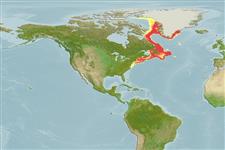>
Gadiformes (Cods) >
Gaidropsaridae (Rocklings)
Etymology: Gaidropsarus: Greek, ga, ge = the earth + Greek, ydro = water + Greek psaros = speckled, starling (Ref. 45335).
Issue
More taxonomic studies (Ref. 1371).
Environment: milieu / climate zone / depth range / distribution range
Ökologie
seewasser benthopelagisch; tiefenbereich 0 - 2000 m (Ref. 58426). Boreal; 76°N - 35°N, 77°W - 36°W (Ref. 56843)
North Atlantic and Arctic.
Size / Gewicht / Alter
Maturity: Lm ? range ? - ? cm
Max length : 40.0 cm TL Männchen/unbestimmt; (Ref. 4926)
Rückenflossenstacheln (insgesamt) : 0; Afterflossenstacheln: 0.
Epibenthic; feeds on crustaceans (Ref. 58426).
Life cycle and mating behavior
Geschlechtsreife | Fortpflanzung | Ablaichen | Eier | Fecundity | Larven
Svetovidov, A.N., 1986. Review of the three-bearded rocklings of the genus Gaidropsaurus Rafinesque, 1810 (Gadidae) with description of a new species. J. Ichthyol. 26(1)114-135. (Ref. 9985)
IUCN Rote Liste Status (Ref. 130435: Version 2024-1)
Bedrohung für Menschen
Harmless
Nutzung durch Menschen
Fischereien: nicht kommerziell
Tools
Zusatzinformationen
Download XML
Internet Quellen
Estimates based on models
Preferred temperature (Ref.
123201): 2.1 - 5, mean 3.5 °C (based on 260 cells).
Phylogenetic diversity index (Ref.
82804): PD
50 = 0.5001 [Uniqueness, from 0.5 = low to 2.0 = high].
Bayesian length-weight: a=0.00468 (0.00205 - 0.01068), b=3.08 (2.89 - 3.27), in cm total length, based on LWR estimates for this (Sub)family-body shape (Ref.
93245).
Trophic level (Ref.
69278): 3.4 ±0.49 se; based on food items.
Widerstandsfähigkeit (Ref.
120179): mittel, Verdopplung der Population dauert 1,4 - 4,4 Jahre. (Preliminary K or Fecundity.).
Fishing Vulnerability (Ref.
59153): Low to moderate vulnerability (30 of 100).
Nutrients (Ref.
124155): Calcium = 22.2 [9.3, 54.6] mg/100g; Iron = 0.342 [0.151, 0.794] mg/100g; Protein = 15.9 [14.0, 17.8] %; Omega3 = 0.249 [0.107, 0.563] g/100g; Selenium = 27.6 [9.4, 72.0] μg/100g; VitaminA = 13.2 [2.2, 73.0] μg/100g; Zinc = 0.469 [0.286, 0.803] mg/100g (wet weight);
